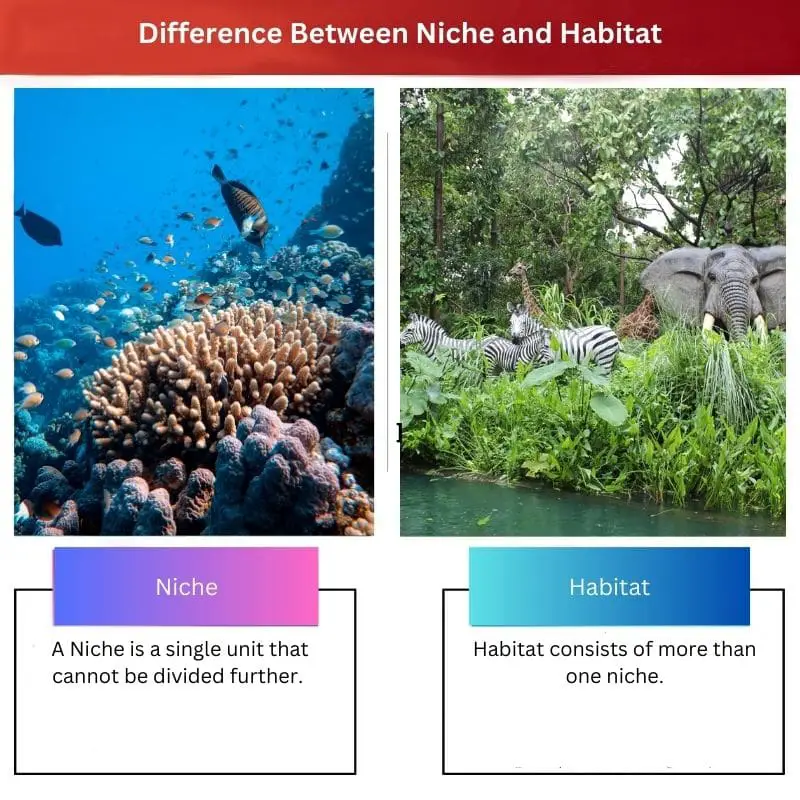Ecology establishes a relationship between humans with nature or the environment. Ecology consists of all organisms, whether individuals, communities, society, forests, ecosystems, biosphere, etc.
Two such terms which are related to ecology are niche and habitat. Niche and Habitat are related and are very important for our ecosystem.
Niche and Habitat help us understand the environment’s abiotic and biotic components. Both are very closely related to each other, and there is a thin difference between them.
Key Takeaways
- A niche is the role of an organism in an ecosystem, including its food source, behavior, and interactions with other organisms.
- A habitat is a natural environment in which an organism lives, including its physical surroundings and resources.
- Organisms can have multiple niches within a habitat, and different habitats can support different niches.
Niche vs Habitat
The word ‘niche’ can be used to define a nest. Most of the birds live in nests. Niche also identifies the behavioural pattern of living beings. It also specifies the needs of the living beings. The size of the niche is small. A habitat is a place where living beings can live. The size of the habitat is big. Mountains are an example of habitat.

Niche is a functional role that tells us about the position of species in the environment and how it reacts, adapts and fights for survival for resources and with predators.
Niche is a subset of habitat, and it means it comes under habitat. A niche is also referred to as an ecological niche when it deals with living beings because it interacts with living beings.
Both abiotic and biotic factors determine niche. Three major types of Niches: trophic niche, spatial or habitat niche, and multidimensional niche.
Habitat is a natural home of a species that lives and exploits the resources for survival, food, shelter, mating and protection. Physical and Biological characteristics play a crucial role for an organism when living in a habitat.
Habitat directly depends on the environmental condition if there is a disruption in climatic conditions due to pollution, volcano, tornado, deforestation, urbanization etc.
A habitat is a larger system, and it composes one or more than one niches.
Comparison Table
| Parameters of Comparison | Niche | Habitat |
|---|---|---|
| Composed of | A Niche is a single unit that cannot be divided further. | Habitat consists of more than one niche. |
| Species | In a niche, at a time, only one species can reside. | In habitat, many species can live at a time. |
| Size | It is small in size. | It is big in size. |
| Trophic Level | It shows the trophic level of an organism in an ecosystem. | It doesn’t show the trophic level of an organism in an ecosystem. |
| Examples | Niche occupied by Pandas or birds in New Zealand etc. | Lakes, Mountains, Grasslands, Desert etc. |
What is Niche?
The word ‘niche’ is coined by Joseph Grinnell in the year 1971. The term ‘niche’ means the nest in which the species lives. Often the word ‘ecological niche’ is misused.
Niche tells us the behavioural pattern of an organism that reacts to competitors like predators, parasites, etc., in an environment. Niche is an ideology that tells about an organism’s requirements and tolerance level.
Niche is a composition of both biotic and abiotic factors. Biotic includes living organisms, and abiotic includes non-living organisms. Niche tells us about the trophic level, i.e., a flow of energy from one organism to another organism.
As soon as the ecological niche becomes empty, it gets filled up by another organism. Niche is very specific to one species. It means that no two species can exist in it at the same time.
If any particular species create its niche, it helps reduce competition between other species.
For example, if there is a species, let’s say birds, birds differ from each other in their eating habits; some of them eat fruits, some nuts and some other small insects.
So we can say that although birds reside in the same habitat, their niche is different because of their eating habits.
Three types of niches can be found in the ecosystem: Spatial, Trophic and Multidimensional. Spatial Niche, also called Habitat niche, deals with the space that is occupied by a species.
The trophic niche shows the food chain of an organism and how it is distributed evenly with others. Multidimensional Niche, also known as Hypervolume Niche, is very complex and difficult to understand as it involves a basic niche as well.

What is Habitat?
The word ‘habitat’ comes from the Latin word ‘habitare’, which means to inhabit or hold. The word has been used since the year 1755. It is described as a natural environment of a being where it lives and grows with its community of plants and animals.
It is very similar to the term ‘biotope’, which means an area where an organism resides.
The factors that are very important for living beings are humidity, temperature, climate, soil and light intensity. There are various types of habitat. Terrestrial habitats include grasslands, forests, wetlands and deserts.
Freshwater habitats include rivers, ponds, marshes, streams, lakes, and bogs. Marine habitats include estuaries, bays, brackish water, the intertidal zone, the sea bed, the open sea, reefs and deep/shallow water zones.
Habitat is a part of the ecosystem, and niche comes within the habitat. Many species live together in one habitat at a time and play their specific role in the ecosystem.
Because so many organisms live in a habitat, it is very difficult to examine the trophic level or food chain of organisms. In habitat, species live for a longer period, unlike niche.
Habitat also influences how the organisms live in the niche. Habitats might change depending upon environmental factors like volcanos, tornados etc. or due to man-made activities such as deforestation, urbanisation etc.

Main Differences Between Niche and Habitat
- A Niche is a single unit that cannot be divided further. It is a subdivision of habitat. Habitat consists of more than one niche. It is a superset that consists of all components in an environment.
- In a niche at a time, only one species can reside. It studies and observes one species at a time. In a habitat, many species can live at a time.
- The niche is small in size. Habitat is big in size, and it is a whole.
- Niche shows the trophic level of an organism in an ecosystem because it is small and is easier to comprehend. Habitat doesn’t show the trophic level of an organism in an ecosystem because it is a part of larger order.
- Examples of Niches include Niches occupied by Pandas or birds in New Zealand etc. Examples of Habitats include Lakes, Mountains, Grasslands, deserts etc.

- https://www.journals.uchicago.edu/doi/abs/10.1086/282837
- https://esajournals.onlinelibrary.wiley.com/doi/abs/10.2307/1942481

The distinction between niche and habitat was very well explained. It made the concepts very clear.
I couldn’t agree more. The clarity provided in the article was exceptional.
The section on what is niche and what is habitat was extremely enlightening. It added great depth to the article.
I completely agree. It was very well-written and informative.
Well said, the article provided a clear and detailed understanding of these ecological concepts.
The article provided a comprehensive overview of niche and habitat. It’s great to see such thorough explanations.
I couldn’t agree more. The depth of information was excellent.
The comparison table was very helpful in understanding the differences between niche and habitat. Well done!
Agreed, the details provided in the article were very enlightening.
I found it very informative as well. Great job in explaining these concepts!
The clarification on the relationship between niche and habitat was very well articulated. It really helped in understanding the concepts better.
I agree, the article did a great job of providing clear connections between niche and habitat.
Well said. The article was excellent in its explanations.
I appreciated the inclusion of real-world examples to illustrate the concepts discussed. Very well done.
Absolutely, the examples really helped to solidify the understanding of niche and habitat.
Great article! The explanation of niche and habitat was very clear and informative.
I agree! The article did a great job of outlining the similarities and differences between niche and habitat.
The detail provided on the trophic, spatial, and multidimensional niches was impressive. Great work in covering all aspects of niche!
Absolutely. It really showcased the thoroughness of the article.
I couldn’t agree more. The inclusion of these details enhanced the article’s quality.
The details provided about the origins and meanings of niche and habitat were very insightful. Great article!
The explanation of how niche and habitat are related was particularly fascinating. I learned a lot from this article.
I had the same experience. The article was incredibly insightful in that regard.